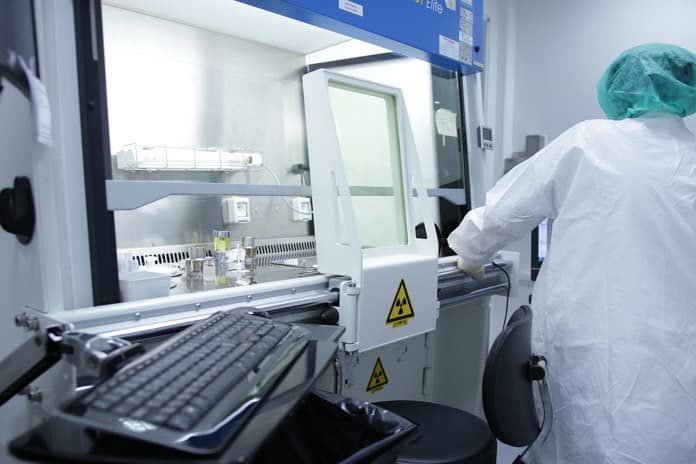A recent review on nanomedicine outlines how nanoparticles can be used to deliver drugs that fight cancer, including both the potential and the challenges.
One of the greatest challenges in treating cancer is delivering drugs to tumor sites effectively with minimum side effects.
The most common form of anti-cancer treatment is called chemotherapy, which involves administering of chemical compounds through the veins.
These chemical compounds fight against solid mass tumors and circulating cancer cells.
While effective in many cases, chemotherapy drugs have properties that often produce a multitude of side effects. Chemotherapy drugs can also harm healthy tissue in addition to treating disease.
In the last several years, scientists have been developing new strategies to deliver drugs to sites of tumor growth.
What is nanomedicine?
One of these approaches is based on nanotechnology. Nanotechnology uses and manipulates tiny synthetic particles.
How small is a nanometer? The average thickness of a human hair is about 100 micrometers. Divide that by 10,000, and you’ve got a nanometer!
By attaching drug molecules to these particles and characterizing their ability to accumulate at tumor sites, researchers have spawned the field of nanomedicine, and opened up the possibility of a completely new method for cancer drug delivery.
Nanomedicine has the potential to fight cancer and minimize side effects.
Several types of nanoparticle drugs have already been approved by the Food and Drug Administration (FDA) for these purposes. While these have indeed shown a decrease in side effects, they have not yet been proven to be effective to work alone in producing therapeutic effects, for a number of reasons.
In general, these have to do with factors that affect how the nanoparticles penetrate solid mass tumors.
A recent review article published in WIREs Nanomedicine and Nanobiotechnology by a group of researchers at Sun Yat-Sen University in China outlines the main obstacles in nanomedicine for the treatment of cancer and the possible solutions to these problems.
The authors start by describing what influences the ability of nanoparticle to penetrate tumors.
They break this down into two main categories: the tumor microenvironment and the properties of the nanoparticles.
The tumor microenvironment
Several characteristics of the local tumor environment complicate the nanoparticle’s ability to penetrate the tumor.
The cells in a tumor have blood vessels around them that are not well-organized like they are in healthy tissue. Ironically, this facilitates and hinders nanoparticle penetration.
These blood vessels are “leaky,” which allows the nanoparticles to accumulate near the tumor in the first place. However, this same leakiness causes insufficient drainage of fluid from the center of the tumor, which makes it more viscous and difficult for nanoparticles to diffuse to the core.
In addition, it creates something called interstitial fluid pressure at the periphery of the tumor, which causes a force outside blood vessels that pushes fluid sharply away.
Lastly, on its journey from blood vessels to tumor cells, a nanoparticle will also encounter a meshwork of flexible proteins called the extracellular matrix.
Its job is to provide structural support and facilitate communication between cells that add up to form tissue. The extracellular matrix represents a major physical barrier that lowers the effectiveness of nanomedicine.
The physical and chemical properties of nanoparticles
Many experiments in the field of nanomedicine have shown that certain characteristics of the nanoparticles themselves are crucial in determining their effectiveness as vehicles for drug delivery. The most important of these properties has proven to be size.
In general, it has been shown that the most appropriate size of a nanoparticle is between 20 and 50 nm.
Particles larger than that diffuse poorly toward the tumor, and very small particles are cleared away very quickly by the body’s excretory system and thus are not allowed the opportunity to make it to the target site. The shape and charge of the particles have also been studied to characterize their effect.
The results are somewhat mixed with regard to what properties are favorable and more research is needed to conclusively determine how they impact nanoparticle performance.
How can we improve tumor penetration?
The authors outline potential strategies to improve the penetration of nanoparticles in solid mass tumors.
The most promising approaches are based on exploiting natural biological stimuli, including enzymatic reactions and local pH levels, to control nanoparticle properties in the human body.
The idea is to synthesize nanoparticles with size-switching properties so that at an initial size they could be retained in the bloodstream for a longer period of time.
Once they reach the tumor, they could be broken down into smaller components that would demonstrate better penetration.
This could potentially be done by taking advantage of an enzyme that could cut some nanoparticles into smaller parts, or use the acidity around a tumor to induce that cutting.
In addition, the extracellular matrix could be broken down by attaching other enzymes to the nanoparticles before delivery.
Big challenges ahead
While the field holds great promise, there are a number of big challenges ahead. Competing considerations for blood retention and tumor penetration complicate the task of designing effective nanoparticles.
Until now, the delivery of nanoparticles has been based on passive diffusion, but more targeted and innovative strategies should be pursued when designing the particles.
Also, degrading the extracellular matrix may allow better penetration, but it may simultaneously free up mobile tumor cells which could spread around to other tissues.
Much work remains to be done, but one way or another, the future of medicine is likely to be at the nanoscale.
Written by Adriano Vissa, PhD
Reference: Zhang, Ya‐Ru, et al. “Strategies to improve tumor penetration of nanomedicines through nanoparticle design.” Wiley Interdisciplinary Reviews: Nanomedicine and Nanobiotechnology (2018): e1519.



